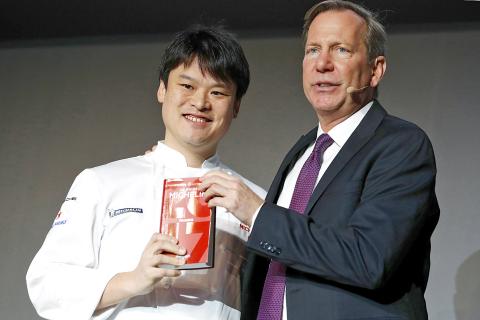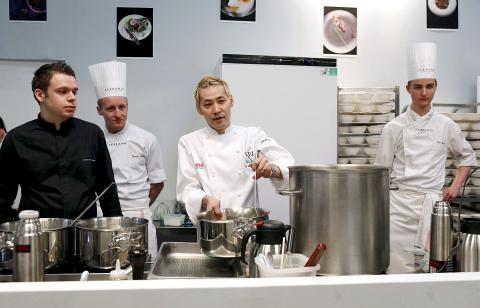For years dining in Paris was great for lovers of French food, and less great for anyone else. You could enjoy?any dish you liked — from Michelin-star fare to the local bistro — so long as it was French.
Now, Japanese are the chefs of the moment, even an American can make his mark and that cool bar in Pigalle may be a taqueria. Anti-immigration policies may be gaining traction in this nation’s election year, but my recent visit shows the foreign arrivals are bringing an excitement and diversity to the city’s restaurant scene that has been sorely lacking.
Here are 10 places to try. Some are cheap, some horribly expensive. Some are modern, some old-fashioned. But the city is hopping.

Photo: AFP / FRANCOIS GUILLOT
Kei: If you have time for one meal in Paris, try for a table at Kei. Chef Kei Kobayashi spent seven years with Alain Ducasse before striking out and now holds two Michelin stars. The room is understated, the staff are attentive and friendly, and the food is fireworks. The signature dish is epic: Garden of crunchy vegetables, Scottish smoked salmon, rocket foam, lemon emulsion, tomato vinaigrette and black-olive crumble. It’s the best salad of my life.
Clown Bar: This tiny joint next to a circus near the Bastille is one of the hottest restaurants in Paris. The tiled room, with an open kitchen at one side, is hot and cramped, with cheerfully informal service. The dishes are simple, full of flavor, and inexpensive for Paris. (The standout starter of veal brain with tosazu vinegar dressing is 12 euros/US$13). Oh, and the chef is Japanese.
L’Entree des Artistes: This small bar round the corner from Clown Bar is cool and yet friendly. It belongs to two friends who have mixed cocktails from New York to London. It’s dark and discreet, and has won several best-bar accolades. It’s about the music and the vibe as much as the drinks, although they are special, too. There are also very good snacks.

Photo: AFP / PATRICK KOVARIK
Verjus: This unstuffy restaurant in the Palais-Royal neighborhood sits atop a low-key wine bar. Verjus is so discreet, Jay Z and Beyonce managed to party in an upstairs room without undue attention while in Paris. There’s a short seasonal tasting menu. If you wonder at the informal service and excellent English, chef Braden Perkins is a Francophile expat from Boston.
Ellsworth: Chef Perkins and his partner Laura Adrian also own this deceptively casual brasserie near Verjus. The menu isn’t divided into starters and mains, there’s just a choice of dishes such as sardines from Noirmoutier, violet potatoes, Meyer lemon, herbs (10 euros); and fried chicken, pickles, cabbage, buttermilk (12 euros). It’s serious food served with a smile.
Bar Hemingway: There’s no point suggesting that a bar at the Ritz is a hidden gem. All kinds have been there before you, including F. Scott Fitzgerald, Gary Cooper and Papa Hemingway himself. But you do have to seek this place out, right at the back of the hotel, and it has a louche style that I love. It would be a great place to conduct an affair. If I ever have one, I am heading back.

Photo: REUTERS / Jacky Naegelen
Le Taxi Jaune: This small joint in the Marais looks like a neighborhood bistro, which it is, in a sense. The menu is chalked on a blackboard, the dishes are simple, the prices are low and the wines are affordable. But owner Otis Lebert has worked in some of the world’s finest kitchens and is a highly talented chef who has chosen to work on the smallest of stages.
Luz Verde: A Mexican taqueria almost certainly won’t be your first choice for Paris, but this lively bar in Pigalle is buzzy and friendly. The food is better than you might expect. Chef-owner Alexis Delassaux previously worked at the excellent and fashionable Frenchie restaurant.
Balls: I came across this new restaurant in the 11th arrondissement by chance and it turned out to be a happy accident. The crowd is young, the service is friendly and the prices low. The menu is simple, with a choice of six meatballs (well, one is veggie) and two sauces for 10 euros.
L’Etoile du Nord par Thierry Marx: Train station brasseries don’t get much better than this new one from celebrity chef Thierry Marx. Here, he offers classic dishes such as steak frites at affordable prices. It would be hard to think of a better place to eat before hopping on the Eurostar.

Exceptions to the rule are sometimes revealing. For a brief few years, there was an emerging ideological split between the Democratic Progressive Party (DPP) and Chinese Nationalist Party (KMT) that appeared to be pushing the DPP in a direction that would be considered more liberal, and the KMT more conservative. In the previous column, “The KMT-DPP’s bureaucrat-led developmental state” (Dec. 11, page 12), we examined how Taiwan’s democratic system developed, and how both the two main parties largely accepted a similar consensus on how Taiwan should be run domestically and did not split along the left-right lines more familiar in

As I finally slid into the warm embrace of the hot, clifftop pool, it was a serene moment of reflection. The sound of the river reflected off the cave walls, the white of our camping lights reflected off the dark, shimmering surface of the water, and I reflected on how fortunate I was to be here. After all, the beautiful walk through narrow canyons that had brought us here had been inaccessible for five years — and will be again soon. The day had started at the Huisun Forest Area (惠蓀林場), at the end of Nantou County Route 80, north and east

Specialty sandwiches loaded with the contents of an entire charcuterie board, overflowing with sauces, creams and all manner of creative add-ons, is perhaps one of the biggest global food trends of this year. From London to New York, lines form down the block for mortadella, burrata, pistachio and more stuffed between slices of fresh sourdough, rye or focaccia. To try the trend in Taipei, Munchies Mafia is for sure the spot — could this be the best sandwich in town? Carlos from Spain and Sergio from Mexico opened this spot just seven months ago. The two met working in the

This month the government ordered a one-year block of Xiaohongshu (小紅書) or Rednote, a Chinese social media platform with more than 3 million users in Taiwan. The government pointed to widespread fraud activity on the platform, along with cybersecurity failures. Officials said that they had reached out to the company and asked it to change. However, they received no response. The pro-China parties, the Chinese Nationalist Party (KMT) and Taiwan People’s Party (TPP), immediately swung into action, denouncing the ban as an attack on free speech. This “free speech” claim was then echoed by the People’s Republic of China (PRC),